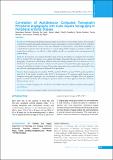Please use this identifier to cite or link to this item:
https://hdl.handle.net/20.500.14356/1055| Title: | Correlation of Multidetector Computed Tomography Peripheral Angiography with Color Duplex Sonography in Peripheral Arterial Disease |
| Authors: | Devkota, Rameshwor Joshi, Birendra Raj Subedi, Kamal Chaudhary, Ranjit Devkota, Ramila Bashyal, Saroja Amatya, Isha Regmi, Pradeep Raj |
| Citation: | DevkotaR., JoshiB. R., SubediK., ChaudharyR., DevkotaR., BashyalS., AmatyaI., & RegmiP. R. (2022). Correlation of Multidetector Computed Tomography Peripheral Angiography with Color Duplex Sonography in Peripheral Arterial Disease . Journal of Nepal Health Research Council, 20(01), 241-246. https://doi.org/10.33314/jnhrc.v20i01.4141 |
| Issue Date: | 2022 |
| Publisher: | Nepal Health Research Council |
| Article Type: | Original Article |
| Keywords: | Computed tomography doppler ultrasound peripheral arterial disease |
| Series/Report no.: | Jan-March, 2022;4141 |
| Abstract: | Abstract Background: With aging of the global population peripheral arterial disease is increasingly common. Arteriography, computed tomography angiography and magnetic resonance angiography are common modalities used for evaluation of peripheral arterial disease. However, they have limitations of being invasive, costly, limited availability or contraindicated in patients with renal impairment or contrast allergy. Duplex imaging, a method of evaluation of peripheral arterial disease is cost effective, widely available and safe even in patients with renal impairment and contrast allergy. Methods: A prospective cross sectional descriptive study involving 114 patients was conducted from November 2015 to October 2016. The patients were evaluated by Doppler ultrasound following multi-detector computed angiography in Department of Radiology, Tribhuvan University Teaching Hospital. The lower limb arteries were divided into 10 segments and stenosis or occlusion of each segment in Computed Tomography angiography were compared with findings in Doppler, Computed Tomography angiography being considered the gold standard. Data was collected in predesigned proforma in Microsoft Excel spread sheet. Results: Duplex imaging showed sensitivity 94.94%, specificity 98.54%, accuracy 97.54%, positive predictive value 96.15 % and negative predictive value 98.06 %. In assessment of 22 segments, partial stenosis seen in Computed Tomography angiography was overestimated as complete stenosis in Doppler. There was significant positive correlation of velocity ratio with degree of partial occlusion (r=0.918 for right lower limb and r=0.895 for left lower limb, p <0.01). Conclusions: Duplex imaging is safe cost effective and reliable method of evaluation of patients with peripheral arterial diseases. Keywords: Computed tomography; doppler ultrasound; peripheral arterial disease. |
| Description: | Original Article |
| URI: | http://103.69.126.140:8080/handle/20.500.14356/1055 |
| ISSN: | Print ISSN: 1727-5482; Online ISSN: 1999-6217 |
| Appears in Collections: | Vol. 20 No. 01 (2022): Issue 54 Jan-March, 2022 |
Files in This Item:
| File | Description | Size | Format | |
|---|---|---|---|---|
| 4141-Manuscript-27900-1-10-20220606.pdf | Fulltext Download | 358.81 kB | Adobe PDF |  View/Open |
Items in DSpace are protected by copyright, with all rights reserved, unless otherwise indicated.
